Mokwheel Granite Review | Is This E-Trike Solid as a Rock?
This affordable tricycle delivers great performance and many customization options, though it has its tradeoffs.
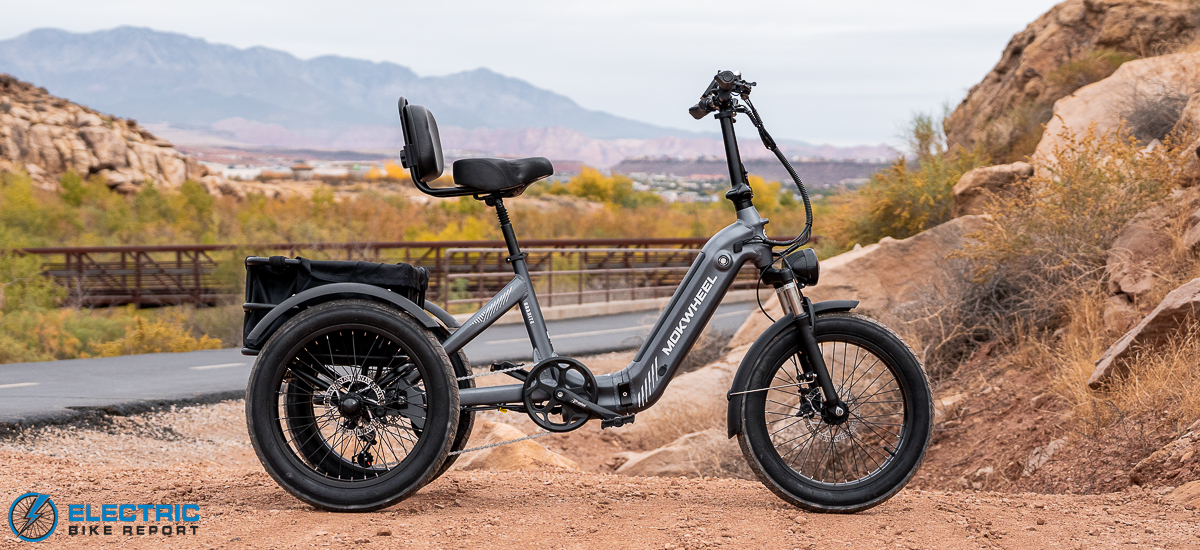
Electric Tricycles are ideal for riders who need extra stability, as their three wheels (compared to the two of an e-bike) add an additional contact point with the ground. Our team of reviewers has seen an increasing number of affordable, sub-$2k e-trikes entering the market, with the Mokwheel Granite being a recent entry from a familiar brand.
Mokwheel earned its reputation as a heavy hitter in the industry with its big, burly “Power Station” fat-tire e-bikes whose massive batteries can power or recharge other devices when combined with an optional power inverter. The brand’s lineup also includes lighter-weight commuters, city cruisers, folding bikes—and now an electric trike.
One of the potential pitfalls of designing an e-trike is deciding what type of motor to employ; many models on the affordable side use front-hub motors that are cost-effective but can lack traction and give the feeling of being pulled along. On the other hand, mid-drive motors that provide a more natural feel can be expensive.
For the Granite, Mokwheel borrowed a clever and effective solution pioneered by Lectric on the XP Trike. It uses a 500W hub-style motor mounted between the rear wheels, which is connected to a differential axle. This combination retains the affordability of a front-hub design with improved traction and the more natural feel of a mid-drive.
Additionally, the trike features a few uncommon line items on its spec sheet that stood out in comparison with other similar models we’ve tested. Its down tube carries a relatively high-capacity 48V, 720-Wh battery, which we expected would lend the Granite better-than-average range.
In contrast with many e-trikes that have mechanical brake systems or hydraulic disc systems with only two rotors, the Granite also has a potential advantage. Its Zoom hydraulic brake system utilizes three rotors (one on each wheel), which we expected would result in better-than-average stopping power.
To find out if our predictions for the Mokwheel Granite were correct, continue to the test sections in our full review below!
Class 2 (throttle to 20 mph)
 Pros
Pros- The Granite has a natural ride feel and great traction thanks to its pairing of a 500W hub motor with a differential axle.
- It offers solid value with a high-capacity 720-Wh battery and the ability to travel further than most other trikes we’ve reviewed.
- Users can customize features such as the number of assist settings, the intensity of the trike’s acceleration, and the type of throttle engagement (Throttle After Pedal or Throttle On Demand).
- Riders can easily control the trike’s speed regardless of how they ride, as the throttle and pedal assist system share five preset limits.
- The Granite performed solidly in our brake test thanks to its hydraulic brake system, which has a line splitter and two rear rotors.
- The trike’s ride is well-cushioned due to its suspension fork with 80 mm of travel and 20×3” street tires.
- Mokwheel’s color display is always a welcome sight; it’s appealing and easy to read.
 Cons
Cons- Considering the trike’s narrower-than-average width, we recommend that Mokwheel reduce its maximum speed to 15 mph from 20 mph.
- We experienced a significant amount of flex from the front of the trike when steering/cornering; we’d prefer a stiffer, more precise feel.
- Our testers found it difficult to pedal the Granite when seated fully on the saddle. A backrest with forward-backward adjustability would be more comfortable.
- Battery:48V, 15 Ah (720 Wh)
- Display: LED Integrated
- Motor: 500W (860W peak), 65 Nm torque
- Headlight:Integrated LED
- Taillights:Integrated LED, with brake light
- Pedal Assist: PAS 1-5
- Claimed Range: 45-55 miles, 20 km/h
- Throttle:Thumb throttle
- App:N/A
- UL Certification:Yes
- Claimed weight: 100 lbs
- Tested Weight: 100 lbs
- Rider height range: 5’0″ ~ 6’2″
- Total payload capacity: 350 lbs.
- Brakes: HB-892E Hydraulic Brake
- Fenders: Front and Rear Plastic
- Fork: 80mm fork travel
- Frame: 6061 Aluminum Alloy
- Drivetrain:Shimano 7-Speed, 44T Chainring, 14-28T Cassette
- Grips: Ergonomic Faux Leather with Gel Support
- Saddle: Customized Comfort Leather Seat
- Handlebar: 620 mm
- Kickstand: Parking Brake
- Pedals: Platform
- Tires: 20×3”
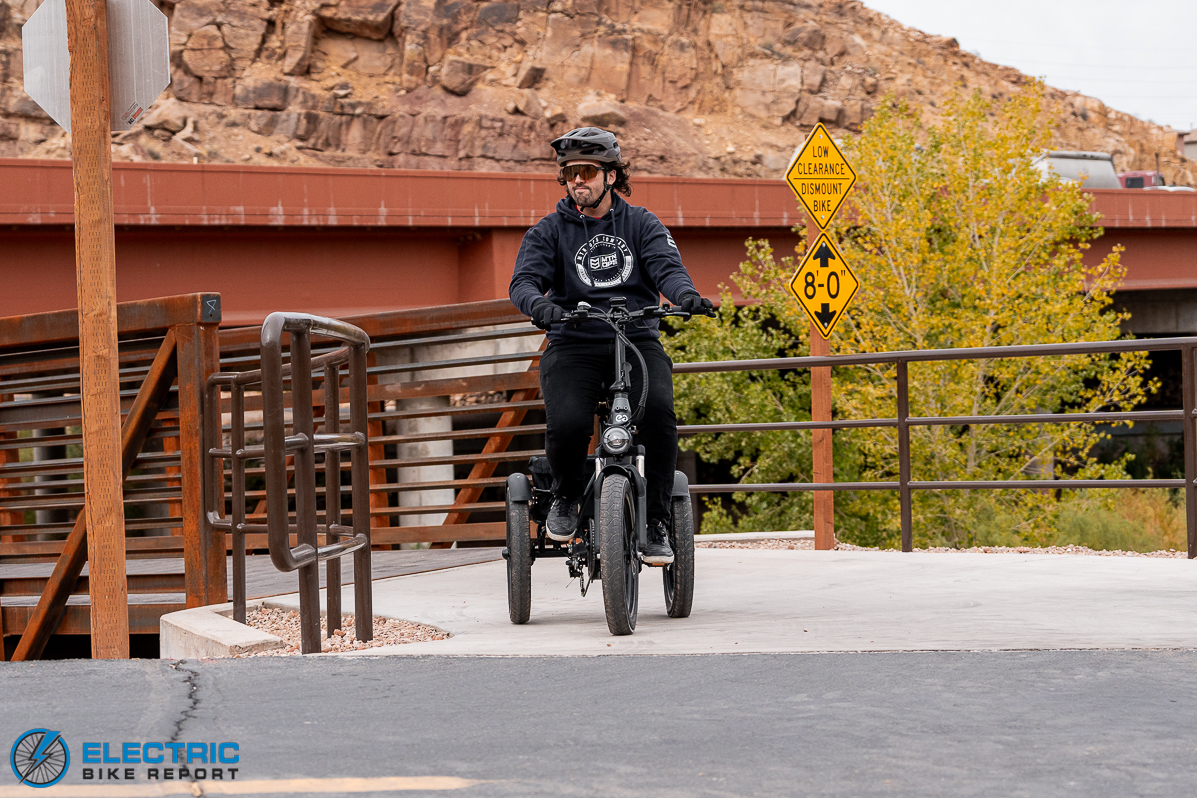
Whether commuting to work or picking up a load of groceries, electric trikes offer more stability than two-wheeled e-bikes.
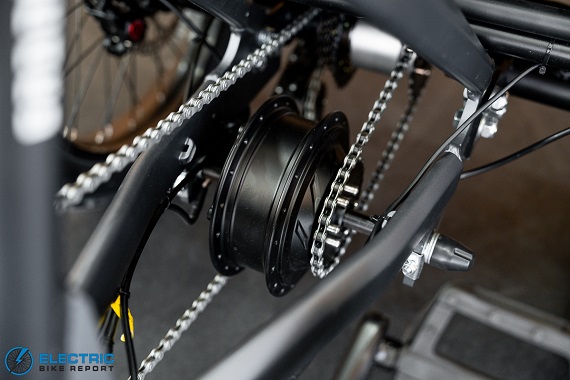
A 500W hub motor drives both wheels through the differential axle.
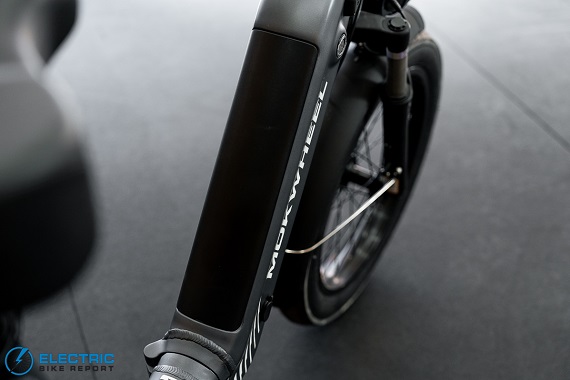
The trike’s 720-Wh battery is fully integrated for a clean, sleek appearance.
Mokwheel Granite Review: Speed Test

To perform our Speed Test with the Mokwheel Granite, I took the trike to our local network of shared-use paths. First, I pedaled the trike with no pedal assist to establish a baseline average speed, and then I stepped up through each of its five pedal assist system (PAS) settings to determine its speed profile. My results are shown in the graph above.
With a 500W motor that uses a cadence sensor, the speeds I recorded are pre-set limits for each PAS level. It is possible to ride faster, but only on leg power, as the trike’s motor stops once the limits are reached.
When considering the graph of the Granite’s speed profile, it (mostly) shows a linear trend that we consider ideal. Such a pattern means that every step up in the PAS level gives roughly the same increase in speed, which tends to feel intuitive.
When going by the numbers, PAS 4 and PAS 5 shared similar speeds on flat ground. Additional testing on hills (more about that later) showed that both settings do have different power levels, but both were able to reach the Granite’s maximum speed of 20 mph.
Basically, the Granite has four standard PAS settings plus an additional power level for climbing hills and carrying heavy loads of cargo.
I also tested the trike’s throttle acceleration, which felt swift and steady. Having reviewed a number of e-trikes previously, I was comfortable with the Granite’s relatively fast pickup, but if you haven’t been on one in a while or if you’re completely new, I’d likely recommend reducing the Motor Intensity setting in the trike’s settings menu.
The Granite has five acceleration settings; the lowest (level 1) makes it a lot more gradual and controlled, while the highest (level 5) feels extra punchy. It ships with the acceleration set to level 3.
This leads me to a fairly big point of critique for the Granite. I liked that it was easy to control my speed through the PAS (the throttle shares the same speed limits as when pedaling), but its max of 20 mph felt a little too fast, especially for the narrower-than-average spacing of its rear wheels.
All trikes can feel somewhat tippy when taking turns too fast, but this was more pronounced on the Granite. Its rear wheels are spaced at roughly 24.5” (on center), while the average among other trikes we reviewed was just under 27”, making the Granite less stable overall.
It’s possible to reduce the Granite’s maximum speed through the display’s settings menu, but we’d prefer it to be limited to between 14 and 16 mph (the maximum speeds shared by other trikes we have tested) for safety.
Otherwise, with an intuitively programmed pedal assist system and easily controllable speeds, the Granite performed well in this test. It has a range of speeds and power levels that should make the trike approachable to most riders.
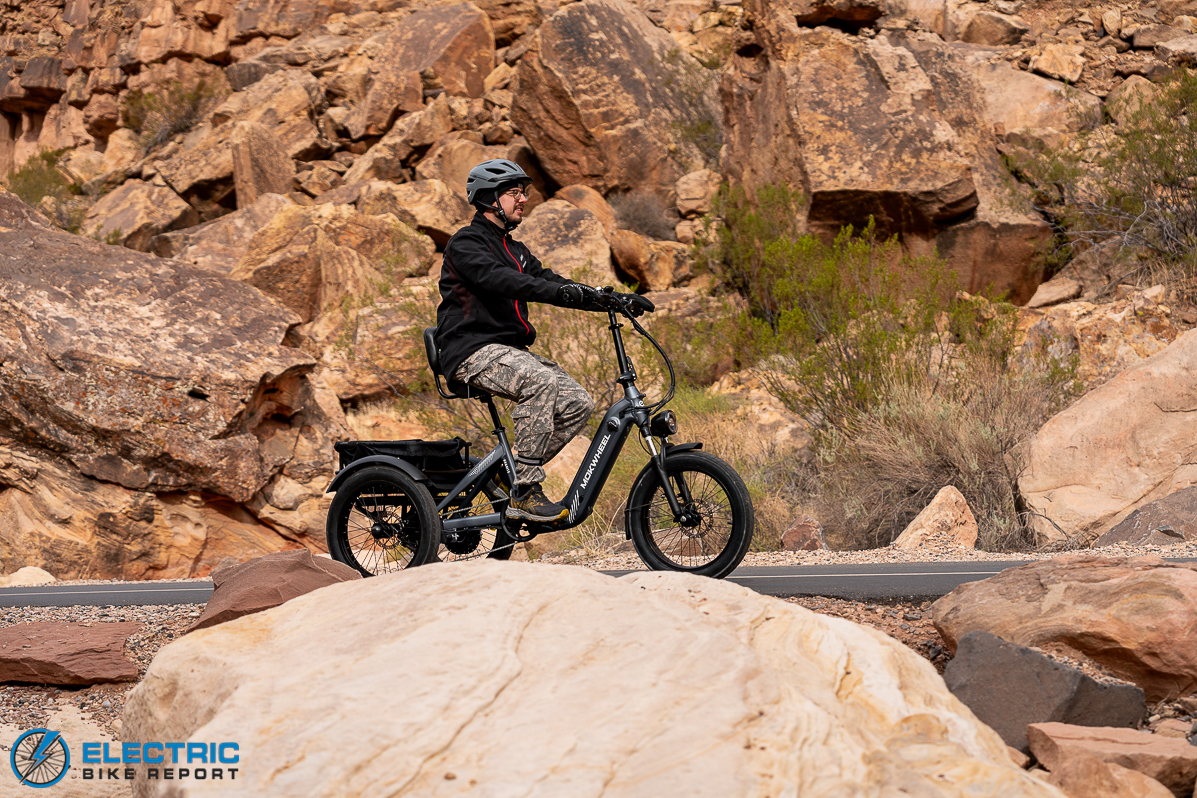
Riders can easily control the Granite’s speed using its five assist settings, each with different power levels and speed limits.
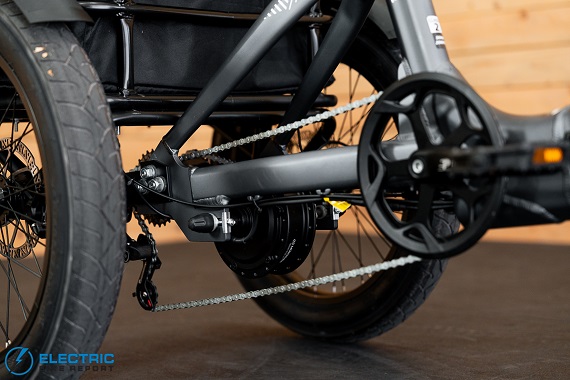
A 7-speed drivetrain offers a variety of gearing options to make climbing hills efficient.
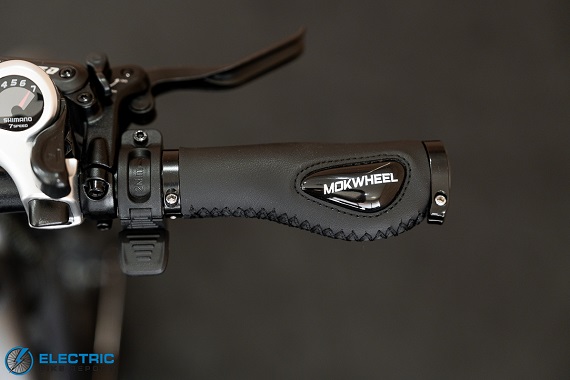
The trike’s throttle lever and shifter sit on the right handlebar within easy reach of the grip.
Mokwheel Granite Review: Range Test

In our Range Test, we tested the efficiency of the Granite’s 500W motor and 720-Wh battery by pedaling the trike along a network of paved shared-use paths until it ran out of charge. Thanks to its high-capacity battery, the Granite gave us what is (at the time of writing) the longest high-power range test we’ve seen from a trike!
In most reviews, we perform two tests: a high-power trial to find a minimum range and a low-power test to determine a maximum range. Our testing methods were somewhat different in this case. Riding a trike for 50-100 miles at ten mph across multiple days can be expectedly not fun, so we decided to do only the high-power test on trikes going forward.
We also tested the Granite in PAS 3 for its high power test instead of PAS 5—primarily due to the speed concerns I mentioned in the Speed Test above, but also so that we could better compare its results to those of other trikes we’ve tested.
With its speed limited to 16 mph in PAS 3 (as determined above), our result of 40.7 miles should be achievable by most riders when not carrying cargo. Based on our test, we think it’s reasonable for those who choose to use a lower and slower assist level to reach Mokwheel’s advertised range of between 45 and 55 miles.
Our testing shows that the Granite can certainly go the distance! And even when you burn through the battery charge, it won’t take long to recharge thanks to the included 3-amp fast charger. This unit can top up the 720-Wh battery in roughly 5 hours.
Mokwheel Granite Review: Hill Test
As shown in the graph above, the Granite successfully completed our Hill Climb Test at Hell Hole Trail using both its throttle and pedal assist system. While we don’t focus on speed when discussing e-trikes (slower is safer) and instead prioritize completion, the Granite did a great job.
Compared to similar e-trikes we’ve tested, it finished the throttle portion 19 seconds faster than the category average of 2:08. It finished the pedal test 22 seconds faster than the electric trike average of 1:56.
Both results were a little unexpected considering that, at a hefty 100 lbs, the Granite weighs about 20 pounds more than average. Additionally, neither its motor’s peak of 860W nor its 65 Newton-meter (Nm) torque is anything outside of the norm.
It is possible that Justin, our rider for this test, got some extra momentum with the Granite’s faster-than-average maximum speed. It’s also possible that Mokwheel’s programming allows the trike’s motor to reach its peak output faster and sustain it for a longer period of time when compared to similar models we’ve tested.
To ensure that the Granite was capable of moving extra weight effectively, I personally tested the Granite with and without a 57-lb sandbag in its cargo basket at our secondary test location called Pilot Hill. This location is not as extreme as Hell Hole, but it’s similar; most riders would likely choose to walk instead of pedal.
First, I tested the trike in PAS 4 and PAS 5 with no cargo. Considering that the Granite’s speeds in both settings were the same on flat ground, my goal was to discover whether the two settings had different power levels. I finished the PAS 4 test in 1:23 and the PAS 5 test in 1:30 with a 1.1 mph difference in speed, so there was a noticeable increase in power.
Next, I tested the trike with the sandbag in PAS 5. I saw a difference of only 8 seconds in the throttle test (1:28 unladen vs. 1:36 with cargo) and 6 seconds in the pedal test (1:23 vs. 1:29). In both cases, the trike felt nearly the same; clearly, it is plenty capable of moving extra weight even up a steep hill.
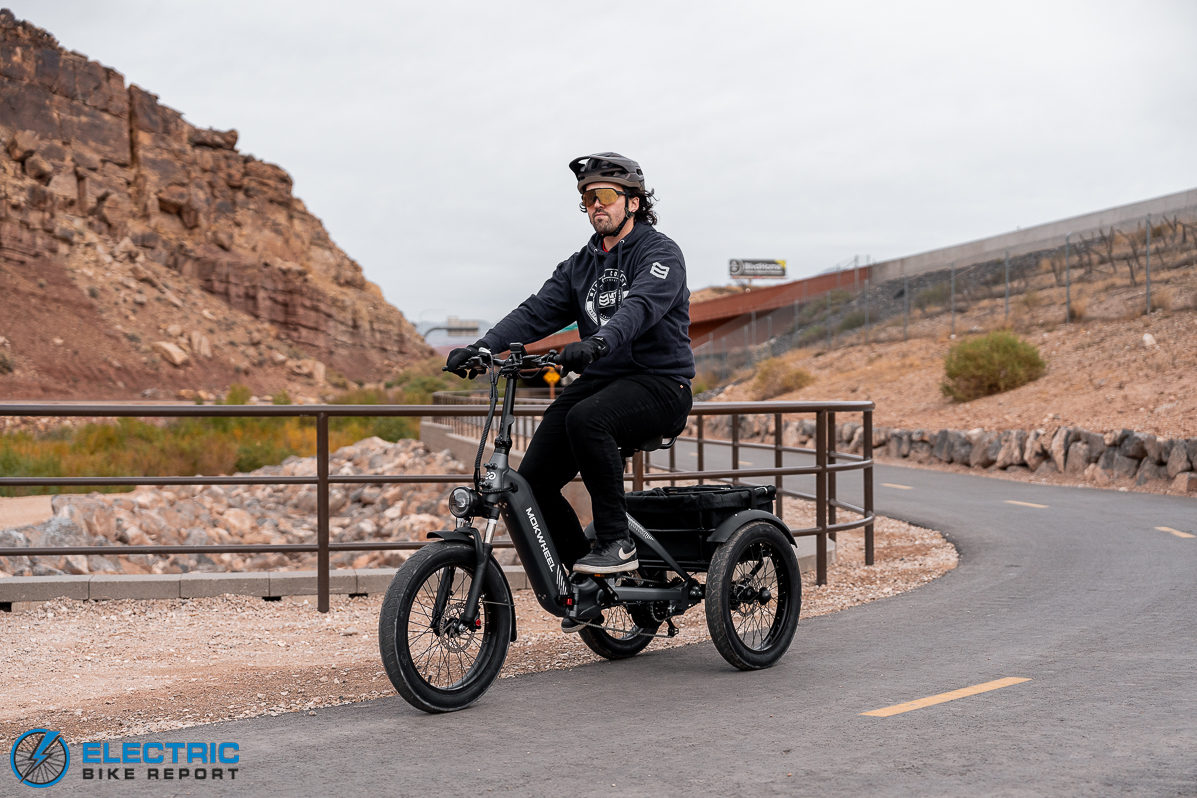
The Granite has a 350-lb payload capacity with the ability to carry up to 220 lbs in the included rear basket and up to 55 lbs in an optional front basket.
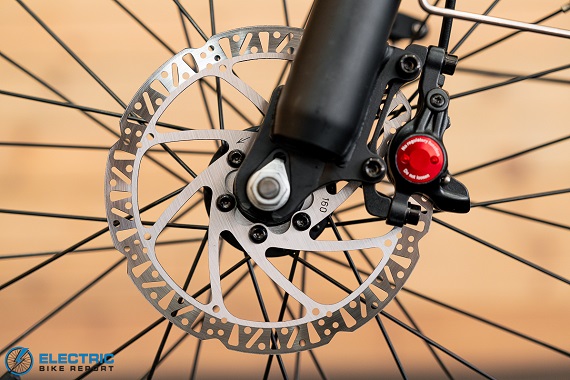
The Zoom hydraulic disc brake system performed well in our testing.
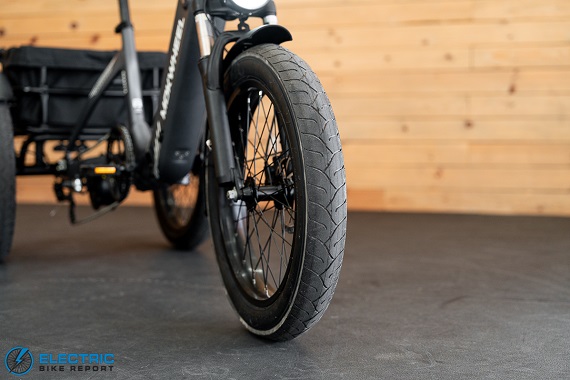
The smooth 20×3” street tires provide stability, traction, and a bit of extra cushion.
Mokwheel Granite Review: Brake Test
We used the method described above to find the Granite’s average stopping distance in our Brake Test. After three tests, this figure turned out to be 13 feet and 2 inches.
It is important to note that the Granite’s top speed of 20 mph is significantly faster than the 14-16 mph maximum of most other models we’ve tested. For consistency, we tested the Granite using its 3rd level of pedal assist, which tops out at 16 mph. Keep in mind that the stopping distance will be extended when traveling faster.
Another thing to mention is that the pool of other trikes we’ve tested is relatively small, and about half of the others used mechanical disc brakes instead of hydraulics. This small data set with significant differences in brake systems makes comparison difficult.
To keep things simple, I’ll compare the Granite directly with the top-selling Lectric XP Trike I mentioned previously. Impressively, the Granite’s average stopping distance tied that trike in this test, so it clearly has effective stopping power, but its differences are also worth mentioning.
As I mentioned in the intro, Mokwheel’s trike uses three rotors vs. the two that are more common in the other models we’ve tested. Its rear brake line makes use of a splitter so that both rear calipers can be operated with the same lever. To balance out this difference, it also uses 160-mm rotors instead of the more common 180-mm rotors.
Ultimately, this system proved to be highly effective at controlling speed and stopping the trike both with and without cargo. The brakes felt great during my testing, allowing me to stop quickly in a controlled manner without feeling too aggressive.
Our verdict? The Granite is equipped with safe and effective brakes that are well-suited to its heavier-than-average weight and cargo capacity.
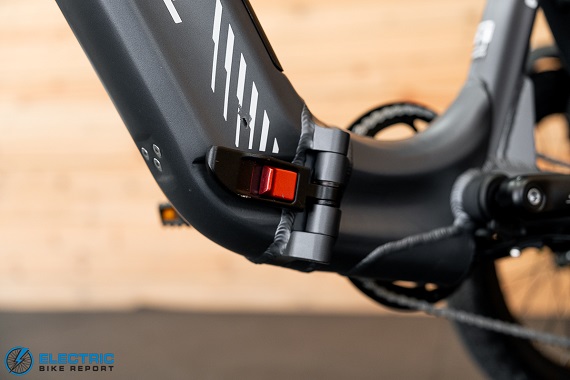
The trike’s frame includes a central hinge allowing its footprint to be reduced.
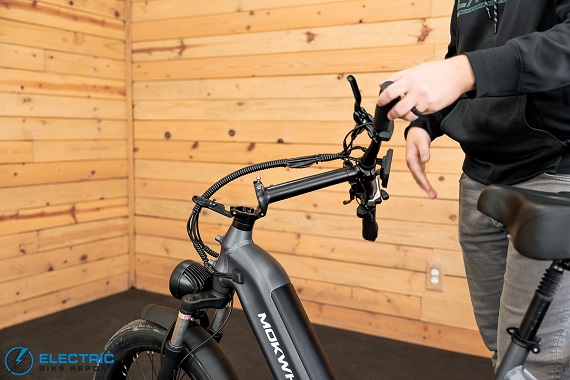
The suspension fork includes both a lockout and preload adjustment.
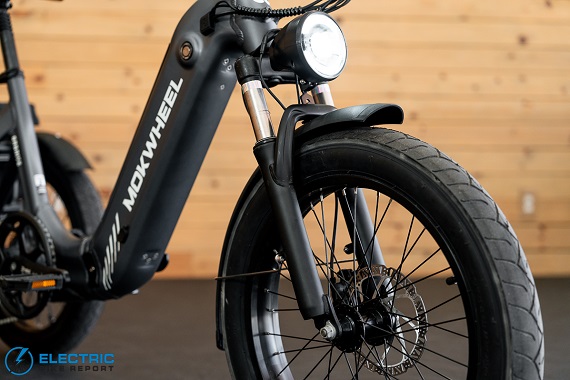
We liked the big, bright headlight mounted to the Granite’s suspension fork.
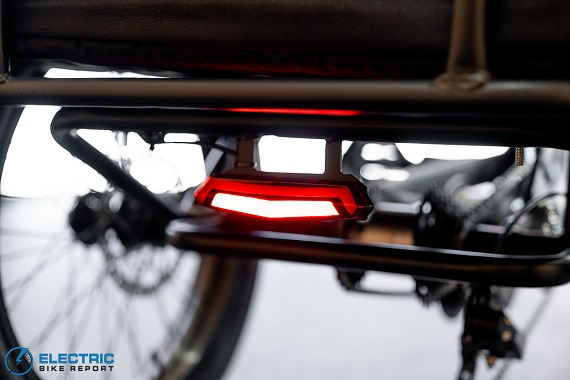
A tail light beneath the cargo basket functions as a brake light.
Mokwheel Granite Review: Ride Quality
The topic of Ride Quality is more subjective than our other test sections, but we will try to paint a picture of what it is like to ride the Mokwheel Granite. This section will cover elements such as sizing/fit, motor engagement, the user interface, comfort and suspension, handling, etc.
The Granite is recommended for riders from 5’0” to 6’2”. At 5’11”, I felt this to be generally appropriate; I had both the handlebar and saddle height maxed out during my testing. With 4.5” of adjustment in the former, I found it comfortable with the trike’s upright riding position, though I was not able to reach full leg extension with the 6” range in the seatpost.
Usually, this would be cause for concern, but we do not consider it a problem on an e-trike with a cadence sensor. The Granite does not require active pedaling, so maximum efficiency is not essential; its ride is instead relaxed and low-effort (if the rider chooses to pedal at all). Those seeking an effort-free experience can simply use the throttle.
In fact, pedaling the Granite was somewhat tough due to its large (but quite comfortable) saddle and non-adjustable backrest. The shape of the saddle impeded the motion of my legs when sitting fully against the backrest; I had to perch on the edge to be able to pedal. We’d prefer the backrest to be adjustable forward-backward for more comfortable pedaling.
Generally, the ride was comfortable due to the aforementioned saddle, ergonomic grips (faux leather with gel support), and the trike’s suspension. The Granite features a suspension fork with 80mm of travel to reduce the impact of bumps on the handlebars. Ours also included a suspension seatpost (an optional but recommended accessory).
Handling was an area that suffered; we noticed a significant amount of flex from the Granite’s frame, particularly when cornering. Whether caused by the battery cutout in the down tube, the hinged frame itself, or something else, the steering felt loose and imprecise. We encourage Mokwheel to strengthen the frame to improve its stiffness in the future.
As indicated by our Speed Test and Hill Test, the Granite’s motor is plenty powerful. Its engagement was somewhat inconsistent, varying between near-immediate and over ½ turn of the cranks, but it did not feel too quick or delayed. We’d have liked a reverse-throttle function to make navigation easier, but this feature seems rare in our experience.
The trike’s user interface was welcome and familiar; Mokwheel’s custom color display is always pleasant to see and use. The readout is clean, well-organized, and easy to read, though the control panel’s buttons can be difficult to distinguish between when wearing gloves or going simply by feel.
We were pleased to note the bike’s integrated headlight, tail/brake light, and fenders, as well as the included cargo basket. With up to 350 lbs of capacity, including the rider (up to 220 lbs in the rear basket and up to 55 in the optional front basket), the trike is well-equipped for hauling right out of the box.
In summary, the Granite’s ride quality was good overall—with comfort and ease of use being some of its highlights—though it was not without room for improvement.
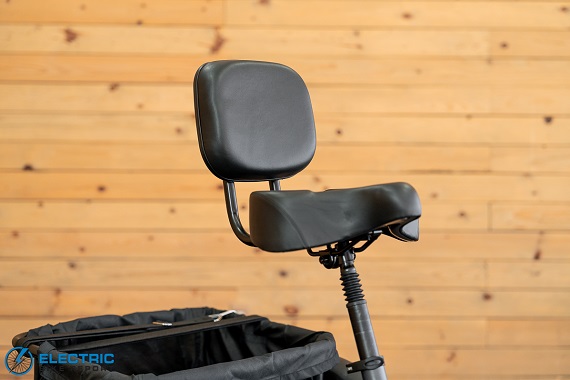
We liked the comfort factor of the Granite’s saddle, but we’d prefer its backrest to be more adjustable.
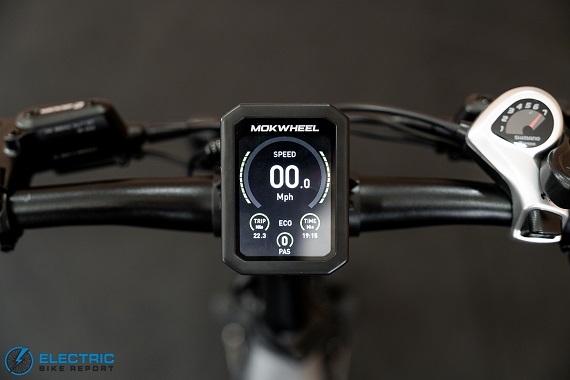
We like Mokwheel’s color display, which presents ride data in a clear, organized manner.
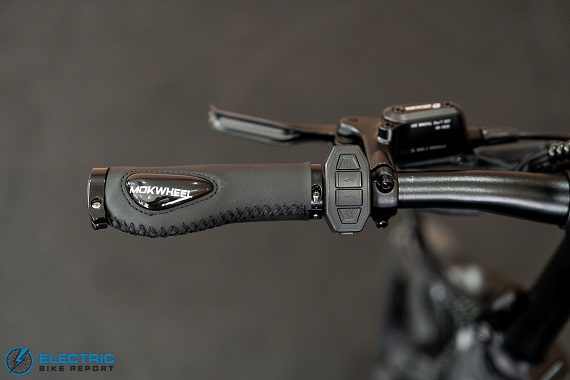
Mokwheel’s custom faux leather grips include gel support bumps.
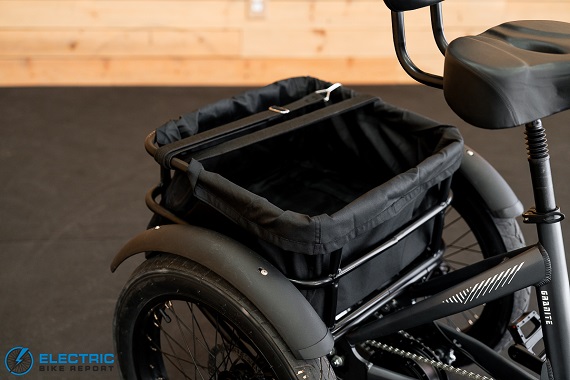
The basket included with our test trike included a fabric liner and a bungee cord to keep the cargo secure.
Mokwheel Granite Review: Summary / Where to Buy
Electric tricycles are a quickly expanding segment of the electric vehicle/e-mobility device market, with more and more e-bike brands venturing into the space. Considering our previous positive experiences testing and reviewing Mokwheel e-bikes, we are excited to see the brand branching out from its roots.
The Granite’s spec sheet piqued my interest at the beginning of this review, but its performance impressed me throughout our testing. It proved to have a generally well-programmed pedal-assist system, solid range for its battery size, great stopping power thanks to its hydraulic brakes, and excellent climbing ability with its capable, quiet motor.
This shows that Mokwheel is on the right track with the Granite, though we identified a few key areas with room for improvement. We recommend that the brand reduce the trike’s maximum speed (though this can be done by the user), reinforce its frame for added stiffness, and opt for a saddle with a more adjustable backrest.
Otherwise, the Granite may be a good option for riders seeking stability, the ability to cover long distances, and the power needed to tackle hills and carry a load of groceries or other cargo. With a few tweaks, it could be even better.
Happy Riding! Make sure to let us know if you have any questions or if you think we left anything out in our comments section in this review of the Mokwheel Granite.


